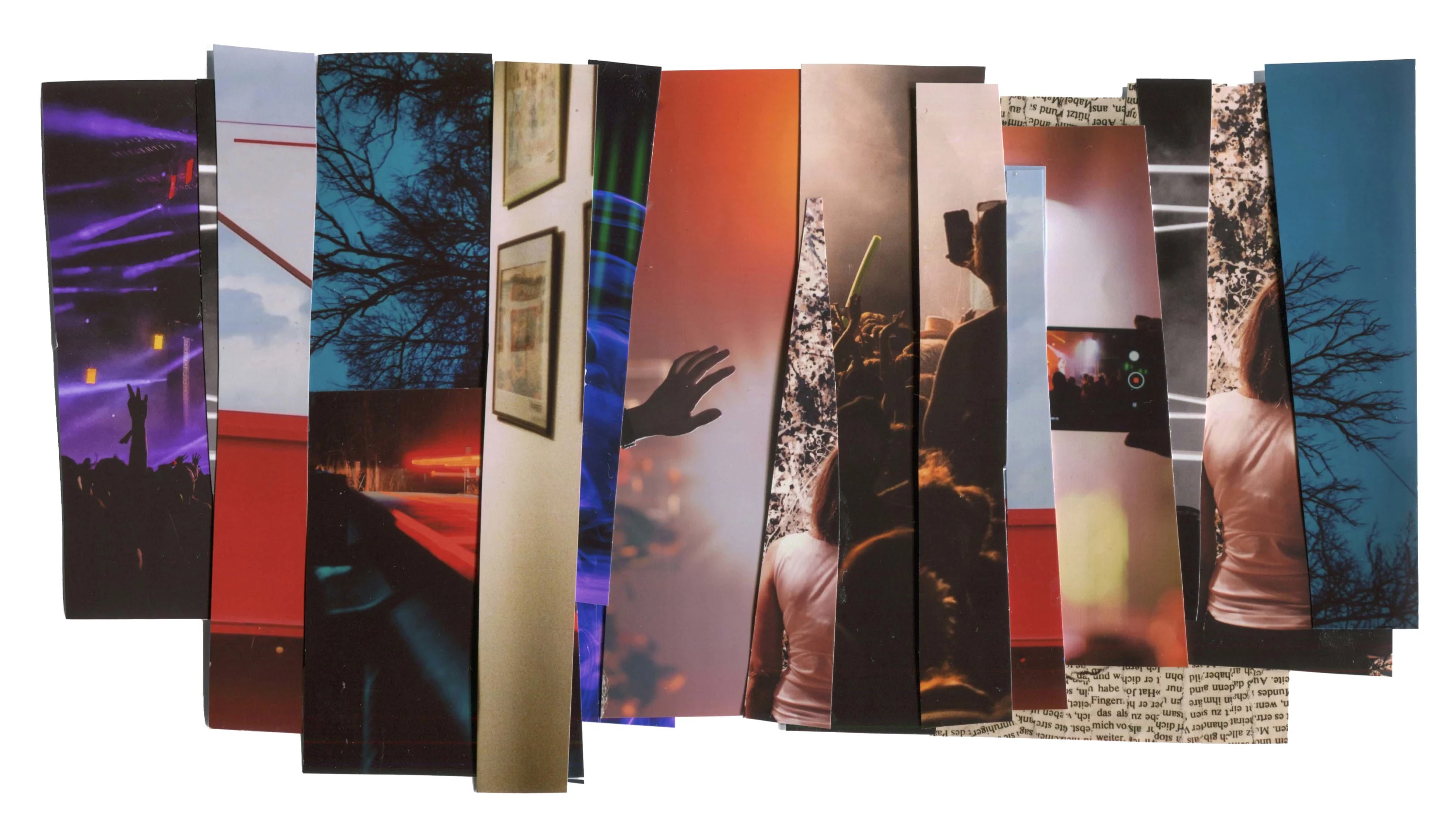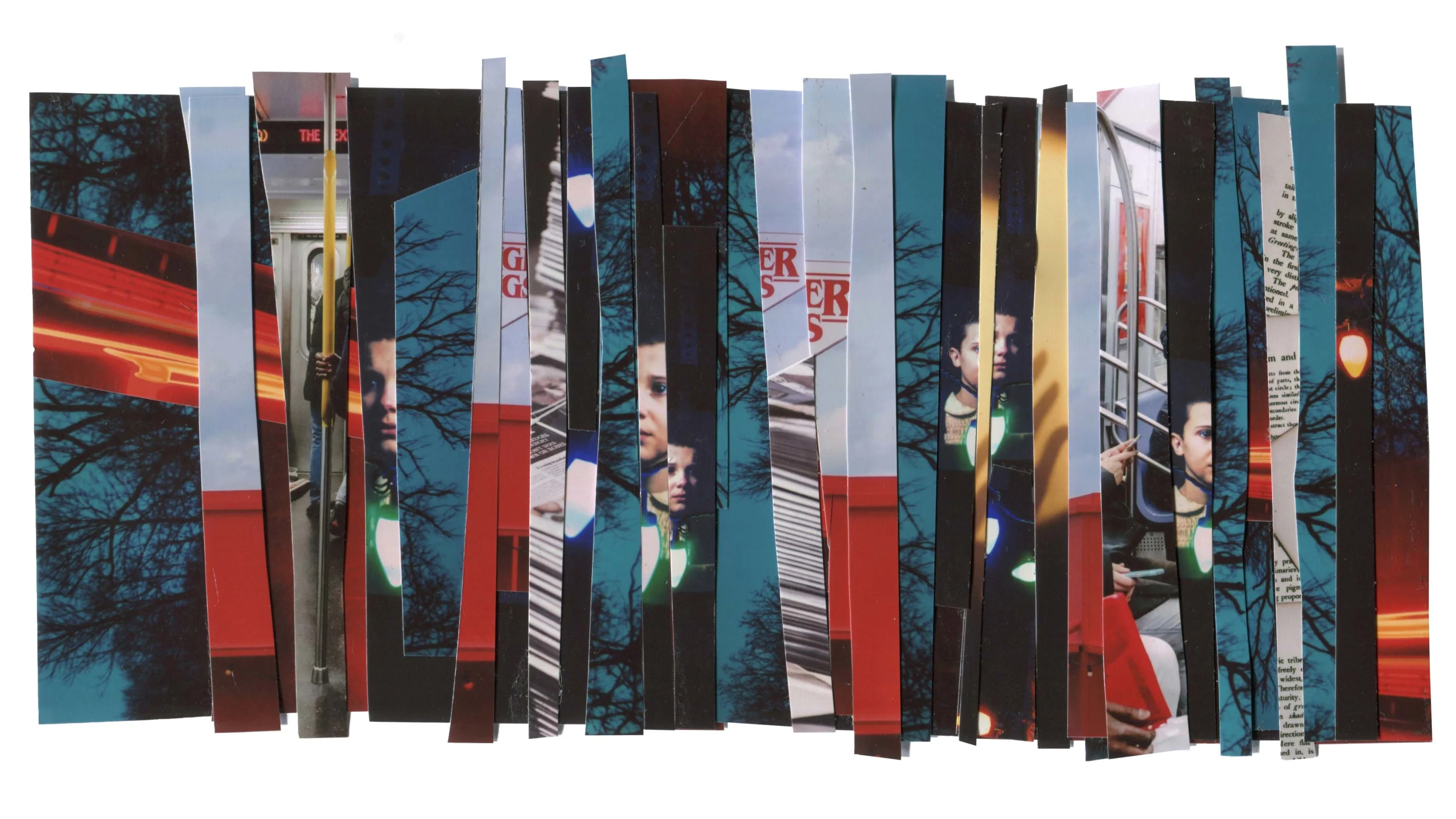

Today, many of us consume content in segments, divorced from the larger bodies of work they’ve been snipped from—TikTok choruses and movie stills, pithy headlines and context-less photos. But is that necessarily a bad thing? Writer Rachel Schwartzmann explores the rise of so-called “snippet culture,” and the notion that brevity and depth are mutually exclusive.
Collages by Virginia Echeverria.
I was sitting at my dining room table when my fiancé, John, handed me his phone. “Have you read this article yet?” he asked me, his voice rising over the whirring air conditioning unit. It was a late summer morning during yet another heatwave. Faint light streamed through the blinds, and his screen appeared as a kaleidoscope of color and pattern.
Half asleep, I blinked slowly. “Nope, not there yet,” I mumbled.
John shook his head and scoffed. “Oh, well, don’t bother. The headline is the story.”
I knew he was half joking, but the fact that he’d concluded a few words could encapsulate an entire piece was both chilling and unsurprising. We live in a time when nearly everything is being reduced to bite-sized moments, and we can’t bring ourselves to finish a whole song or a movie. But what does that say about how we consume culture and move through the world?
As someone who came of age in tandem with social media, I think back to the ringtones and Facebook statuses of my youth—melodies and quotes proclaiming “This is how I feel, this is who I am,” often pulled from songs, books, or films. These instances were among my earliest introduction to how ideas existed outside of their larger body of work. I didn’t know it then, but this was a primer for what’s become known as “snippet culture.”

My education didn’t stop there. In high school, I launched a Tumblr to include in my college application portfolio, and that (now-defunct) style blog laid the groundwork for the boutique content company I founded at age 20. I grew the business for nearly a decade, and I’ve only very recently recognized how scattered my attention was during those years. There was always something to consider or plan for, making it hard to engage with and enjoy what was right in front of me.
Eventually, I became disillusioned with the expectation to prioritize business output over purpose. As I navigated intense burnout, I knew it was time to scale back and return to my roots as a writer. The decision ultimately led to the beginnings of “Slow Stories,” a podcast and platform that explores slowing down against the backdrop of our digital world.
Since the project’s inception, I’ve spoken with countless creative professionals about what it means to live, work, and create today; and at the forefront of this exploration is our relationship with pace, and why slowing down is not only beneficial, but critical. Yet even as an advocate for lengthy, thought-provoking works that often take time to properly digest, I’ve started to wonder if brevity and depth are mutually exclusive. I often find myself moved by a single stanza, fragmented narratives, or individual episodes of a television series. Surely value can be derived from shorter, more accessible forms of storytelling?
Take the resurgence of Kate Bush’s “Running Up That Hill (A Deal with God),” for instance. As Netflix’s hit show “Stranger Things” dominated the pop culture conversation earlier this year, my TikTok For You page featured videos paired with that famous snippet:
As a ’90s baby, I can’t say I grew up listening to Bush. Yet as these lyrics poured out of my phone speakers, I realized this soundbite was not only giving the song a second life on the charts, but also encouraging a deeper investigation—whether that’s into the artist and her discography herself, or our own feelings, or something else entirely. Like Bush said (via her landline!) in an interview for Woman’s Hour radio show with Emma Barnett: “I really like people to hear a song and take from it what they want.” (Yes, I’m sharing a snippet here, but trust me when I say their whole conversation is a worthwhile listen!)
Accordingly, snippet culture is an exercise in choice and context. Viral clips may come and go, but they provide an opportunity to wade into the larger story.
This idea rings true for Diana Weymar. As the creator and curator of the Tiny Pricks Project, an art-activism initiative for which she stitches resonant quotes onto textiles, Weymar told me she is “more concerned with time than content.”
“I am interested in how long the eye, mind and heart are engaged,” she said. “A snippet can be very evocative. I feel that I am elongating…the text that I select because the medium implies time and the handmade. It takes time. We can see that in the stitching. Knowing how something is made can slow down our interaction with it.”
In terms of what dictates her creative decisions and expectations, she added, “I always go with my feelings…Does the text make me feel something?”

Ahead of the publication of her debut story collection, “Bad Thoughts,”writer Nada Alic produced a series of short films depicting scenes from the book. “For many of us, digital spaces are our primary reality, so when you’re putting art out into the world, you’re tasked with how to present it and yourself online,” she said. “Putting my first book out in 2022 meant getting creative about how to reach people where they’re at.”
“I don’t know if every writer needs to do what I did,” she continued, “but making short films, designing T-shirts, hosting events, and multimedia performances around my book launch definitely helped me connect with new readers who otherwise would’ve never heard about my book. I’m always thinking about the reader who maybe isn’t necessarily already engaged in a literary community but loves music, podcasts, and films that are in conversation with my book. What can I do to reach her? How do I cut through the noise and translate my voice for different mediums? You’re asking a lot from people with a book. You’re asking them to spend hours and days with your work, inside your mind. I wanted to make it worthwhile and meaningful, and reach as many people as I could.”
The idea of meeting people where they are has never felt more relevant, especially as we rise to meet culture where it’s at—often in real-time. As the lines between the virtual and physical continue blurring, the effects of snippet culture aren’t relegated to the digital space. Recently, I visited the Brooklyn Museum to see “Figures of Speech,” an exhibition featuring the work of the late creative visionary Virgil Abloh. Like other visitors, I was keen to snap a few photos, but as I made my way through the crowds, I was struck by the pace at which people were moving. Often, phones came into view before faces. There seemed to be a level of urgency in trying to document every corner.
As we milled out of the exhibition, I asked John if he’d seen everything he wanted. He nodded, though I wondered about the past shows we’d breezed through, catching quick glimpses of famed artworks or missing an important detail altogether.
The experience called to mind my “Slow Stories” interview with New York-based gallery owner Hannah Traore. During our time together, Traore and I chatted about the responsibility viewers have when engaging with art. When I first posed the idea, Traore was slightly surprised. “I think about viewership a lot and about who’s seeing the work, what that means, and what context that kind of brings to the conversation—but I’ve never thought about the responsibility of the viewer,” she said. Our primary responsibility, she later suggested, is to give the work a chance—and ask questions about our reactions.
Thinking about how snippet culture informs our offline experiences, I asked a couple of artists if we’re also responsible for engaging with an entire exhibit, even if we only connect with one or two pieces. How do we know where to begin and end our experience when consuming art IRL?
“When we enter an in-person art experience, inevitably, some pieces will speak louder to the viewer than others. And that’s totally ok!” artist and curator Janie Korn told me. “Breezing by some work while taking time to consider others is an essential part of recognizing your own artistic preferences. It’s a process of trusting your intuition to discern what you like and what you dislike.”
While Korn notes that consuming art within an algorithm is an easier route, she contends that “non-digital spaces” can be an important domain to hone one's sensibility, as they offer more context and opportunity to engage with the unknown. “It's hard to grow artistically, I think, when you're exclusively being served helpings of what you already know and love,” she said.
Similarly, Brooklyn-based artist Didi Rojas said: “I don’t think anyone has a general responsibility to spend time on something they don’t feel a connection to, but I think it’s our fast-paced life approach that keeps us from connecting. I like to approach viewing art with intention…We may not end up connecting every time we see art, but by questioning—even if we think [they’re] silly questions—we’re opening up to learning about the world and, at the same time, ourselves.”

There may be nuances across their disciplines, but speaking with these creatives revealed a pattern: our relationship with time remains crucial to what we create and consume, and how much time we consistently devote to either pursuit is constantly evolving.
A few days after the headline incident, John and I found ourselves in a similar scene: phones in hand, coffee coursing through our bodies, a new day about to begin. By that point, the heatwave had broken, and so had the silence. John asked: “Consuming a shorter piece of work should mean we have time to do more, right?”
I raised my eyebrows. “More” didn’t necessarily feel right unless it preceded with intention. Shrugging, I shifted my gaze toward the end of the table. My eyes landed on a postcard we’d purchased at the “Figures of Speech” exhibition, which featured Abloh’s long-standing philosophy: “QUESTION EVERYTHING.”
The demands of modern life can make it hard to weigh what’s worth our attention. But as we collectively navigate a changing world, perhaps we should take a moment to recalibrate our perspective. After all, snippet culture puts the onus to go deeper on us. It’s a reminder of our agency; an invitation to slow down and ask questions. Maybe in this way, less can be so much more.

